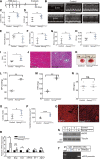Low-Level Nanog Expression in the Regulation of Quiescent Endothelium
- PMID: 32640900
- PMCID: PMC7447188
- DOI: 10.1161/ATVBAHA.120.314875
Low-Level Nanog Expression in the Regulation of Quiescent Endothelium
Abstract
Objective: Nanog is expressed in adult endothelial cells (ECs) at a low-level, however, its functional significance is not known. The goal of our study was to elucidate the role of Nanog in adult ECs using a genetically engineered mouse model system. Approach and Results: Biochemical analyses showed that Nanog is expressed in both adult human and mouse tissues. Primary ECs isolated from adult mice showed detectable levels of Nanog, Tert (telomerase reverse transcriptase), and eNos (endothelial nitric oxide synthase). Wnt3a (Wnt family member 3A) increased the expression of Nanog and hTERT (human telomerase reverse transcriptase) in ECs and increased telomerase activity in these cells. In a chromatin immunoprecipitation experiment, Nanog directly bound to the hTERT and eNOS promoter/enhancer DNA elements, thereby regulating their transcription. Administration of low-dose tamoxifen to ROSAmT/mG::Nanogfl/+::Cdh5CreERT2 mice induced deletion of a single Nanog allele, simultaneously labeling ECs with green fluorescent protein and resulting in decreased Tert and eNos levels. Histological and morphometric analyses of heart tissue sections prepared from these mice revealed cell death, microvascular rarefaction, and increased fibrosis in cardiac vessels. Accordingly, EC-specific Nanog-haploinsufficiency resulted in impaired EC homeostasis and angiogenesis. Conversely, re-expression of cDNA encoding the hTERT in Nanog-depleted ECs, in part, restored the effect of loss of Nanog.
Conclusions: We showed that low-level Nanog expression is required for normal EC homeostasis and angiogenesis in adulthood.
Keywords: cardiac hypertrophy; coronary vessels; endothelial cells; haploinsufficiency; quiescence; tamoxifen; telomerase.
Conflict of interest statement
None.
Figures








Similar articles
-
Low-dose 6-bromoindirubin-3'-oxime induces partial dedifferentiation of endothelial cells to promote increased neovascularization.Stem Cells. 2014 Jun;32(6):1538-52. doi: 10.1002/stem.1658. Stem Cells. 2014. PMID: 24496925 Free PMC article.
-
Estrogen receptor-alpha and endothelial nitric oxide synthase nuclear complex regulates transcription of human telomerase.Circ Res. 2008 Jul 3;103(1):34-42. doi: 10.1161/CIRCRESAHA.107.169037. Epub 2008 Jun 2. Circ Res. 2008. PMID: 18519947
-
Kallistatin attenuates endothelial senescence by modulating Let-7g-mediated miR-34a-SIRT1-eNOS pathway.J Cell Mol Med. 2018 Sep;22(9):4387-4398. doi: 10.1111/jcmm.13734. Epub 2018 Jul 11. J Cell Mol Med. 2018. PMID: 29992759 Free PMC article.
-
Vascular senescence and ageing: a role for the MEOX proteins in promoting endothelial dysfunction.Can J Physiol Pharmacol. 2017 Oct;95(10):1067-1077. doi: 10.1139/cjpp-2017-0149. Epub 2017 Jul 20. Can J Physiol Pharmacol. 2017. PMID: 28727928 Review.
-
Molecular mechanisms involved in endothelial cell aging: role of telomerase reverse transcriptase.Z Gerontol Geriatr. 2007 Oct;40(5):334-8. doi: 10.1007/s00391-007-0482-y. Z Gerontol Geriatr. 2007. PMID: 17943236 Review.
Cited by
-
Identification of Diagnostic Markers in Infantile Hemangiomas.J Oncol. 2022 Dec 1;2022:9395876. doi: 10.1155/2022/9395876. eCollection 2022. J Oncol. 2022. PMID: 36504560 Free PMC article.
-
A requirement for Krüppel Like Factor-4 in the maintenance of endothelial cell quiescence.Front Cell Dev Biol. 2022 Nov 8;10:1003028. doi: 10.3389/fcell.2022.1003028. eCollection 2022. Front Cell Dev Biol. 2022. PMID: 36425528 Free PMC article.
References
-
- Wang XY, Lan Y, He WY, Zhang L, Yao HY, Hou CM, Tong Y, Liu YL, Yang G, Liu XD, et al. Identification of mesenchymal stem cells in aorta-gonad-mesonephros and yolk sac of human embryos. Blood 20081112436–2443doi: 10.1182/blood-2007-07-099333 - PubMed
Publication types
MeSH terms
Substances
Grants and funding
LinkOut - more resources
Full Text Sources
Molecular Biology Databases
Research Materials
Miscellaneous

